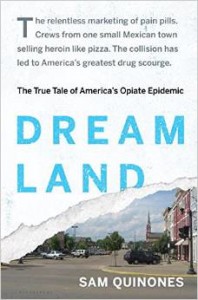Grassroots Revival
Second of three parts

I think one reason is the fascinating details he revealed about the legwork and research that went into his book. Yet I see another reason—the power of his encouragement for people to appreciate the difference individuals can make.
He talked about the importance of the 2016 national, state and local elections and how many “little people” think they can’t influence the process.
“You can,” he said. “Speak up. Tell people what you’re thinking.”
A Collective Impact
His comment reminded me of a statement I heard long ago: the collective impact of many small actions is more significant than one major event.
Therein lies the brief explanation of the drug crisis that affects every corner of our nation. One by one, people who got lost in their problems or an excessive self-focus turned to drugs as a solution. The impact decimated our society.
However, lest we get mired in gloom, Quinones offered rays of hope. Among the positive steps that he outlined were the grassroots actions “little” people can take that matter in the long run.
His leading example involved residents of Portsmouth, Ohio, a once-thriving city that had been blindsided by the pill mills that mushroomed across Appalachia in the 1990s. After moving to get those phony operations closed down, in 2009 local investors rescued an old shoelace factory that had closed and was about to sell its equipment.
At its peak, the company and support businesses had employed 5,000 at a series of locations. Though it looked doomed, the author told of several leaders coming together and declaring, “We can’t let this happen.”
Although a fraction of its old self, today the restored plant sits on five acres and ships its products around the world instead of those shoelaces coming from overseas.
Restoring Community
Quinones said the community took other positive action, including the seemingly minor step of installing lights in a city park. Yet that led to a decline in drug activity and prostitution there.
A city coming together illustrated Quinones’ leading recommendation: that cities and towns everywhere restore community life to the center of their respective societies.
Heroin and pills are the antithesis of community, Quinones said, since they encourage people to escape into self and hide in the shadows of self-seeking, self-serving pleasure.
Much of what he talked about involves common sense. Things like parents controlling their children’s cell phone and video game use so they don’t wind up addicted to electronics and don’t know how to carry on a conversation. Mentioning he had a daughter nearing teenage life, he commented, “I’m not buying her a phone,” a comment that prompted cheers from the audience.
Rejecting Marijuana
Less than two weeks after his talk, voters in my home state of Ohio demonstrated the power that inherently resides in people who band together and say, “Enough!”
Instead of giving in to the well-funded marijuana forces trying to bring the legalized pot bandwagon into their states, voters soundly rejected the attempt by a margin of nearly 2-1.
This struck me as the kind of significant “no” that could signal the start of a renaissance in the overwhelming fight against further opening the door to the gateway drug to heroin. I didn’t fall off the turnip truck yesterday; I realize the well-funded, politically-powerful marijuana forces won’t stop.
Yet, Quinones has removed one of their key arguments—that marijuana will be a financial panacea and a source of increased tax revenue. Next time, I’ll review what the former LA Times reporter said about that.



